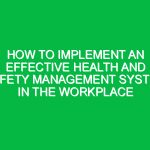Introduction
In today’s fast-paced work environment, ensuring the health and safety of employees is paramount. One crucial aspect of workplace safety is the proper use of Personal Protective Equipment (PPE). In this comprehensive guide, we will delve into the importance of PPE in the workplace and provide valuable insights for both employers and employees.
What is PPE?
Personal Protective Equipment, or PPE, refers to protective clothing, helmets, goggles, or other garments or equipment designed to protect the wearer’s body from injury or infection. PPE plays a vital role in creating a safe work environment by reducing the risk of exposure to hazards.
Types of PPE
There are various types of PPE designed to protect against different hazards. Some common examples include:
– Safety helmets
– Safety goggles
– High-visibility clothing
– Gloves
– Respirators
– Ear protection
The Importance of Proper PPE
Proper PPE usage is crucial for maintaining a safe workplace environment. It not only protects employees from potential hazards but also ensures compliance with health and safety regulations. Employers must provide suitable PPE for their workers and ensure that it is used correctly.
For Employers
Employers have a legal responsibility to provide their employees with appropriate PPE. They must conduct risk assessments to identify potential hazards in the workplace and provide the necessary protective equipment. Additionally, employers should train their employees on how to properly use and maintain PPE.
For Employees
Employees play a vital role in ensuring their own safety by using PPE correctly. They should attend training sessions on PPE usage, inspect their equipment regularly, and report any defects or issues to their supervisors. By following proper PPE protocols, employees can protect themselves from workplace hazards.
How to Choose the Right PPE
When selecting PPE, it is essential to consider the specific hazards present in the workplace. Employers should choose equipment that provides adequate protection against these hazards and ensure that it fits each employee properly. Comfort and ease of use are also crucial factors to consider when selecting PPE.
Training and Education
Training employees on the proper use of PPE is essential for ensuring its effectiveness. Employers should provide comprehensive training sessions that cover how to wear, adjust, and maintain PPE correctly. Regular refresher courses can help reinforce proper PPE practices among employees.
Maintaining PPE
Proper maintenance of PPE is essential for ensuring its longevity and effectiveness. Employees should inspect their equipment regularly for signs of wear or damage and replace any damaged items immediately. Employers should also establish a system for tracking and replacing PPE as needed.
Conclusion
In conclusion, the importance of proper PPE in the workplace cannot be overstated. Employers and employees must work together to ensure that the right protective equipment is provided, used correctly, and maintained effectively. By prioritizing workplace safety through the use of PPE, organizations can create a safer and healthier work environment for all. Remember, safety first!


